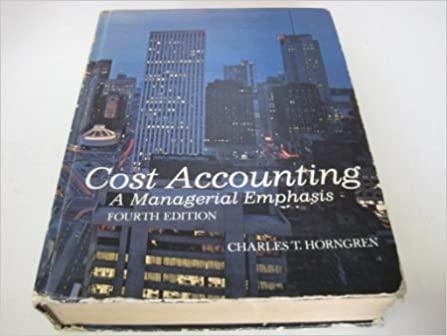Cost Behavior and Cost-Allocation Alternatives Joe, how do you think we ought to charge ourselves for the
Question:
Cost Behavior and Cost-Allocation Alternatives “Joe, how do you think we ought to charge ourselves for the operation and upkeep on our new airplane?
It seems to me there are several ways we could decide to allocate expenses, and I don’t know which is the best way.
“There must be some method which is better than others. Now that I think about it, other airplane partnerships I have heard about charge each member of the partnership a fixed monthly amount plus a variable charge depending on how much each man flies the airplane. What’s wrong with doing it that way?”
“Nothing, maybe, Joe. Let me go home and take a look at the projected costs we estimated last week for our new bird. Then we’ll get back and talk about it.”
Jim, a recent business school graduate, had met Joe one day at the local airport after completing a local training mission with one of his students. Jim had started flying before entering the service and continued both in the service and part time while in school. Joe was a relatively new pilot who worked nearby as a sales engineer. Their conversation quickly indicated both were interested in acquiring their own airplane but that doing so alone was prohibitively expensive. The idea of a partnership of course came up and, as is often the case, the result was an agreement to jointly purchase and own, on a 50-50 basis, a high-performance light aircraft. The purchase and bank financing for the deal had been completed last week; at that time Jim and Joe had sat down to develop cost estimates for ownership and operation of the equipment.
When Jim arrived home after talking to Joe about the cost allocation question, he pulled out of the file the data he had referred to and began thinking about appropriate allocation procedures. The data follow:
Airplane purchase price $25,000 Partner’s initial capital investment
(split evenly) 5,000 Amount financed 20,000 f Monthly loan amortization payment
(11 percent 5-year note) 430 PAP Liability and Hull insurance, per year 1,200 — ¥
la Airport tiedown, per year 360 7 Se
/ Annual inspection /2 |432 3 {
vy Maintenance—per flight hour 10 4 v Fuel and oil—per flight hour 9 ra: i
© Estimated annual usage: é HY Joe 200 flight hours ere (eS Jim 100 flight hours ;
Jim knew of course that loan amortization, insurance, aircraft tiedown, and annual inspections were fixed charges in that they continued whether or not the airplane was flown. On the other hand, maintenance, fuel, and oil varied in direct proportion to flight time, as shown in the data above. At this point in their discussions Jim and Joe had agreed they both wanted to maintain 50 percent ownership of the airplane—which suggested to Jim they ought to each pay a fixed $215 monthly to cover loan amortization (and resultant equity build-up) outlays. It also was clear to Jim that the maintenance, fuel, and oil charges ought to accrue to each partner in proportion to aircraft hourly flight utilization, given the obvious direct relationship between the cost behavior for these items and flight time. The difficult question over which Jim now puzzled was how to best allocate the fixed expenses (other than loan amortization) shown in the schedule above. He recognized that they too, along with the loan amortization expenses, could be: shared equally by Joe and himself; but he wasn’t convinced that would be the best way to do it. One reason he felt this way was because the fixed expenses in question were costs of operation, as opposed to basic ownership, just like the variable charges. :
At this point in Jim’s deliberations Joe called and said “Listen, Jim, let’s get together in an hour and settle the costing question. I want to go flying tomorrow and I want to know what its going to cost.”
Jim hung up and decided to develop what he felt were two alternative ways of costing the airplane. He wanted to document the major advantages of each method so they could examine the issues and come to a conclusion that night.
. Give Jim a hand. Assume that Jim and Joe will actually fly the very number of hours they have estimated. Develop the monthly bill of both Jim and Joe under each of the two alternatives implicitly suggested in the italicized part of the case (immediately before Joe’s phone call).
. If both Jim and Joe are alert in their upcoming meeting, Jim will likely favor one approach and Joe the opposite. Which is each likely to favor? Prepare a set of arguments supporting both positions. How are they going to have to settle their conflicting viewpoints? lop2
Step by Step Answer:






